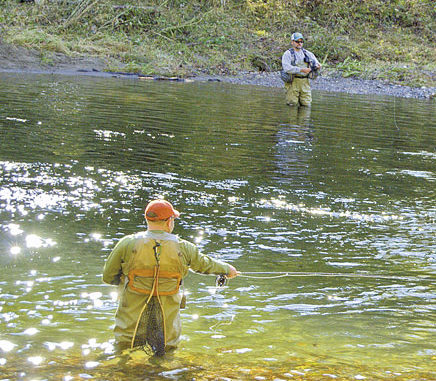
Every year, more and more people, young and old, male and female, take up the fine sport of fly-fishing. As a result, more fly-fishing opportunities have opened to fly fishers, including high-dollar fishing tournaments and new fly-fishing-only streams.
The North Carolina Wildlife Resources Commission has long recognized the growing popularity of fly fishing, setting aside four streams for fly fishing only: a section of the Elk River and Lost Cove Creek in Avery County, the upper portion of the Davidson River in Transylvania County and part of the South Toe River in Yancey County.
Additionally, North Carolina State Parks operates a fly-fishing-only stream in Stone Mountain State Park: Bullhead Creek, which originates and ends in Stone Mountain State Park in Wilkes and Alleghany counties. Some of the largest trout in the southern Appalachians inhabit this 2-mile-plus stream, trout that run 30 inches and longer.
The park operates the stream as fishing-for-fun enterprise. Anglers pay a nominal fee and are assigned to one of eight sections or “beats,” as they are called. That section belongs exclusively to the angler until he or she quits for the day and checks out. The trail that runs beside the stream is closed to all other activity, guaranteeing anglers an undisturbed fishing experience.
The most recent addition to the fly-fishing-only program is a 2-mile section of Raven Fork on the Cherokee Indian Reservation. Stocked with trophy-sized trout, the stream is open to fishing year-round, and all fishing is catch-and-release. It is stocked at least once a month with brook, brown and rainbow trout, nothing under 1½ pounds and some weighing 10 pounds or more.
Robert Blankenship, who manages the program, said with supplemental feedings, he expects to see trout in the 12- to 15-pound range. Plans are to eventually expand the trophy section to five miles. In addition to a $7 daily tribal permit, anglers must purchase a $10 special permit to fish the trophy waters.
During the catch-and-release season on the state’s delayed-harvest streams, the majority of the anglers are fly fishers. The Tuckasegee River in Jackson County, one of the more popular streams in the program, attracts fishermen from all over the Southeast, many from South Carolina, Georgia and Florida.
This year, Jackson County established the state’s first “Fly Fishing Trail,” which includes 15 prime fishing spots across the county. Although the streams listed on the trail are not limited to fly-fishing, the trail features some of the county’s best fly fishing streams. A map of the trail is available at www.flyFishingTrail .com
Fishing tournaments, once limited to lakes throughout the country, are gaining popularity on trout streams in the western mountains, much to the dismay of some purists.
In September, a “Rumble in the Rhododendron” fly-fishing tournament was held on the Cherokee Indian Reservation, with 21 2-man teams competing for $5,000. That event, now in its second year, was organized by the Eastern Band of the Cherokee Indians and the North Carolina Fly-Fishing USA team. The winners, Josh Stephens of Jackson County and David Woody of Andrews, advanced to the national competition in Pennsylvania.
A member of Fly-Fishing Team USA since 2005, Stephens had the second-highest number of points going into the national tournament. Stephens, 32, developed his fly-fishing skills on the Nantahala River in Macon County. He has competed in numerous national and international fly-fishing competitions.
The Nantahala Outdoor Center in Macon County held its first fly-fishing competition in mid-October. Competitors were limited to one fly, and the tournament attracted a sizable number of entries. Organizers plan to make it an annual event.
Once the sport of wealthy “gentleman” fishers, fly-fishing has become popular with people from all economic levels, men as well as women. Guide services number in the dozens, offering guided trips as well as expert fly-fishing instruction. Just about any weekend during the delayed-harvest season, you can spot a half-dozen or more guides, many in drift-boats, working the Tuckasegee River.
Trout fishing in general has had a positive impact on local economies in Western North Carolina, according to a study sponsored by the N.C. Wildlife Commission and conducted by Responsive Management and Southwick Associates.
The study, “The Economic Impacts of Mountain Trout Fishing in North Carolina,” found that nearly 93,000 trout anglers spent an estimated $146 million on mountain trout fishing trips and equipment in 2008. The secondary effects of these dollars boosted the total to $174 million.
Money spent on mountain trout fishing in 2008 supported a total of 1,997 jobs and provided an estimated $56 million in income, the study reported. Most of the workers who benefitted were in western North Carolina.
The study group conducted a telephone survey of 1,232 randomly selected licensed anglers 18 years and older who fished for mountain trout in 2008.




Be the first to comment